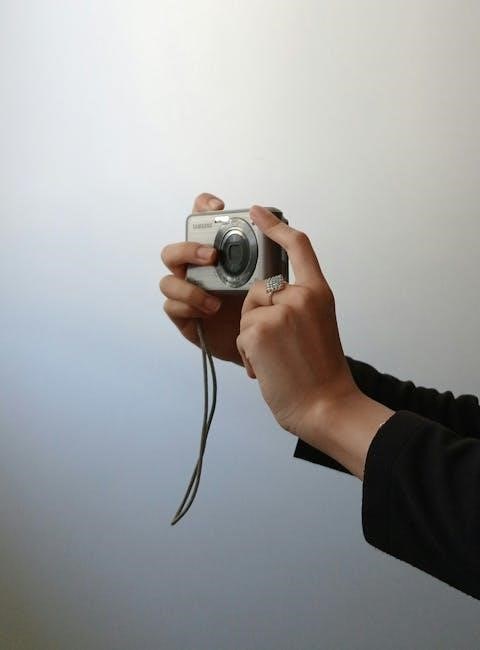Welcome to the Guard Thermometer Manual! This guide provides essential information for safe and effective use of your thermometer‚ ensuring accurate temperature measurements and optimal performance.
1.1 Congratulations on Your Purchase
Congratulations on acquiring the Guard Thermometer! This manual is your comprehensive guide to unlocking its full potential. Thank you for choosing a product known for accuracy and reliability. Designed with ease of use in mind‚ the Guard Thermometer promises precise temperature measurements‚ ensuring your safety and confidence. Whether for home‚ medical‚ or workplace use‚ this device is built to deliver consistent results. Take a moment to review this manual thoroughly to familiarize yourself with its features and proper operation. Your satisfaction is our priority‚ and we are excited to support you in utilizing this advanced tool effectively.
1.2 Important Safety Information
Before using your Guard Thermometer‚ it is essential to read and understand the safety guidelines to ensure safe and effective operation. Improper use or handling may lead to inaccurate measurements or damage to the device. Avoid exposing the thermometer to extreme temperatures‚ moisture‚ or physical stress. Keep it out of reach of children and use it only for its intended purpose. Follow all instructions carefully‚ and never attempt to modify the device. Proper storage and handling are crucial to maintaining its accuracy and longevity. Refer to the specific safety precautions outlined in this manual to ensure optimal performance and user safety. Adhere to these guidelines to guarantee reliable and secure operation of your Guard Thermometer.
1.3 Purpose of the Manual
This manual serves as a comprehensive guide to help users understand and effectively operate the Guard Thermometer. It provides detailed instructions for installation‚ usage‚ and maintenance‚ ensuring optimal performance. The manual covers safety precautions‚ features‚ and troubleshooting to address common issues. By following the guidelines outlined‚ users can maximize the device’s accuracy and extend its lifespan. Whether for personal or professional use‚ this manual equips users with the knowledge needed to utilize the Guard Thermometer confidently and safely. Refer to this manual regularly to ensure proper operation and maintain the device’s reliability. It is designed to be a user-friendly resource for all aspects of thermometer operation and care.

Features and Functions of the Guard Thermometer
The Guard Thermometer features non-contact forehead measurement‚ battery-powered design‚ high accuracy‚ NIST-traceable calibration‚ multi-range switching‚ and a Pt1000 sensor for precise temperature readings.
2.1 Non-Contact Forehead Measurement
The Guard Thermometer offers a non-contact forehead measurement feature‚ ensuring safe and hygienic temperature reading without physical contact. This method is ideal for quick assessments‚ especially in medical settings or for multiple users. The infrared sensor accurately captures body heat from the forehead‚ providing reliable results. It minimizes cross-contamination risks‚ making it suitable for use in clinics‚ schools‚ and homes. The non-contact design also allows for faster measurements‚ enhancing efficiency in busy environments. This feature is particularly beneficial for measuring temperatures in individuals who may be sensitive to direct contact‚ such as children or patients with sensitive skin.
2.2 Battery-Powered and Reusable Design
The Guard Thermometer is designed to be battery-powered‚ ensuring portability and ease of use in various settings. Its reusable design eliminates the need for disposable components‚ making it both cost-effective and environmentally friendly. The device operates on LR44 batteries‚ which provide a typical battery life of 80 hours under normal usage conditions. This feature allows for extended use without frequent replacements. Additionally‚ the reusable nature of the thermometer means it can be easily cleaned and maintained‚ ensuring hygiene and longevity. The battery-powered design also enables seamless operation in remote or power-limited environments‚ while the reusable construction supports long-term reliability and performance.
2.3 High Accuracy and NIST-Traceable Calibration
The Guard Thermometer is engineered for high accuracy‚ delivering precise temperature readings with a NIST-traceable calibration‚ ensuring compliance with industry standards. Its advanced sensor technology provides reliable measurements‚ maintaining consistency across various environments. The thermometer’s calibration process adheres to stringent quality control protocols‚ guaranteeing exceptional performance and trustworthiness. This feature is particularly crucial for applications requiring exact temperature monitoring‚ such as medical or industrial settings. The NIST-traceable certification assures users of the device’s ability to meet precise measurement demands‚ making it a dependable tool for professional and everyday use. Regular calibration ensures long-term accuracy‚ maintaining the thermometer’s reliability over time.
2.4 Multi-Range Switching and Pt1000 Sensor
The Guard Thermometer features multi-range switching‚ allowing users to toggle between eight distinct measurement ranges for versatility in various applications. Equipped with a Pt1000 sensor‚ it ensures high sensitivity and precise temperature detection. This sensor adheres to DIN EN 60571 standards‚ class B‚ guaranteeing reliable performance. The multi-range functionality caters to different environments‚ from industrial to medical settings‚ providing accurate readings across diverse scenarios. The Pt1000 sensor’s durability and accuracy make it ideal for both routine and specialized temperature monitoring. This combination of features enhances the thermometer’s adaptability‚ ensuring it meets the demands of multiple industries and applications with consistent reliability and precision.

Safety Precautions and Handling
Always handle the thermometer with care to avoid damage. Store it in a dry‚ cool place‚ away from direct sunlight and extreme temperatures. Follow proper battery disposal guidelines and avoid exposing the sensor to harsh chemicals or physical stress for optimal performance and longevity.
3.1 General Safety Information
Read this manual carefully before using the Guard Thermometer. Ensure all safety precautions are followed to prevent accidents. The device is designed for non-contact forehead measurements and should not be used for any other purpose. Avoid touching the sensor or exposing it to harsh chemicals‚ as this may affect accuracy. Keep the thermometer out of reach of children and use it only in environments with stable temperatures. Proper handling and storage are crucial for maintaining performance and longevity. Follow all guidelines to ensure safe and effective operation of your Guard Thermometer.
3.2 Proper Handling and Storage
Handle the Guard Thermometer with care to ensure its accuracy and longevity. Avoid exposing it to physical stress or extreme temperatures. Clean the device regularly using a soft‚ dry cloth or an alcohol-free wipe. Store the thermometer in its protective case when not in use to prevent damage. Keep it away from direct sunlight and moisture to maintain performance. Ensure the storage environment has a stable temperature between -40°C and 70°C‚ as specified in the guidelines. Proper storage and handling will extend the life of your Guard Thermometer and ensure reliable measurements. Always check for visible damage before use and follow all recommended maintenance procedures.
3.3 Transport and Storage Temperature Guidelines
When transporting or storing the Guard Thermometer‚ ensure it is kept within a temperature range of -40°C to 70°C to maintain its accuracy. Avoid exposing the device to extreme conditions‚ such as direct sunlight or moisture‚ which could damage the sensor. Use the protective case provided during transport to prevent physical damage. The thermometer’s housing‚ rated IP65‚ offers protection against dust and water ingress but is not submersible. Store the device in a dry‚ stable environment to preserve its functionality. Avoid sudden temperature fluctuations‚ as they may affect calibration. Always check the thermometer for visible damage before use after transport or storage.

How to Use the Guard Thermometer
Welcome to the Guard Thermometer! This section guides you through operating your device‚ ensuring accurate temperature readings every time. Follow these steps for safe and effective use.
4.1 Step-by-Step Operating Instructions
Power on the thermometer by pressing and holding the button for 2 seconds. Ensure the battery is installed correctly.
Select the desired measurement mode using the mode button.
Align the sensor with the forehead‚ maintaining a 1-3 cm distance for accurate readings.
Press the measure button; the LED will flash and beep once the reading is complete.
The display will show the temperature; refer to the symbols guide for additional indicators.
Turn off the device by holding the button for 2 seconds after use.
Regularly clean the sensor lens with a soft cloth to maintain accuracy.
4.2 Measurement Site and Technique
The Guard Thermometer is designed for non-contact forehead measurements‚ providing quick and hygienic temperature readings. For accurate results‚ ensure the forehead is clean‚ dry‚ and free from sweat or obstructions. Align the sensor perpendicular to the forehead‚ maintaining a distance of 1-3 cm. Avoid touching the sensor lens to prevent smudging. Environmental factors‚ such as direct sunlight or extreme temperatures‚ may affect accuracy. Hold the device steady and press the measure button; the reading will appear on the display. Proper technique ensures reliable measurements‚ making it ideal for use at home‚ in clinics‚ or workplaces. Always follow the recommended method for consistent results.
4.3 Understanding the Display and Symbols
The Guard Thermometer features a clear LCD display showing temperature readings‚ battery status‚ and operational modes. Symbols indicate measurement units (°C/°F)‚ low battery‚ or error codes. The display flashes during measurement and shows a steady light once complete. A low-battery icon alerts you to replace or charge the batteries. Error codes like “Err1” or “Err2” indicate issues such as faulty sensors or extreme temperatures. Refer to the troubleshooting section for resolving these errors. Understanding these symbols ensures proper device functionality and accurate measurements. Always check the display for any alerts before taking readings to ensure reliable results. This feature enhances user experience and maintains measurement precision.

Installation and Setup
This section guides you through unpacking and preparing your Guard Thermometer for first-time use. Follow the step-by-step instructions to ensure proper installation and initial configuration.
5.1 Unpacking and Initial Inspection
When you receive your Guard Thermometer‚ carefully unpack the device and accessories from the packaging. Inspect the thermometer for any visible damage or defects. Ensure all components‚ such as the battery‚ sensor‚ and instruction manual‚ are included; Verify the packaging list to confirm completeness. Check the thermometer’s housing for any signs of wear or damage‚ ensuring the sensor is clean and free from obstructions. If any damage is found‚ contact the manufacturer immediately. Properly handling the device during inspection will ensure its accuracy and longevity. Store the packaging for potential future use or transportation.
5.2 Battery Installation and Charging
To power your Guard Thermometer‚ install the provided LR44 batteries. Open the battery compartment located on the rear of the device. Insert the batteries‚ ensuring correct polarity as marked. Close the compartment securely. If your model includes a rechargeable battery‚ connect the USB charger to the port. The charging indicator will light up during charging and turn off when complete. Avoid overcharging to prolong battery life. Typically‚ the battery life is up to 80 hours. Always use the recommended battery type for optimal performance. If the device does not turn on‚ check the battery connections and ensure they are properly seated. Replace batteries as needed to maintain accurate measurements.

Programming and Customization
Program your Guard Thermometer to set measurement ranges‚ activate special features‚ and customize settings for specific applications‚ ensuring precise temperature monitoring tailored to your needs.
6.1 Setting Up Measurement Ranges
Setting up measurement ranges on your Guard Thermometer ensures precise temperature monitoring across various applications. The device features multi-range switching‚ allowing you to select from predefined temperature ranges. To configure‚ navigate to the settings menu and choose the desired range. The Pt1000 sensor supports multiple ranges‚ ensuring accuracy in different environments. Refer to the technical specifications for available ranges. Once selected‚ the thermometer will adjust its settings to optimize measurements for the chosen range. This feature enhances versatility‚ making it suitable for industrial‚ medical‚ or home use. Always save your settings to ensure consistent measurements. Proper range setup is crucial for achieving reliable results.
6.2 Activating Special Features
Activating special features on your Guard Thermometer enhances its functionality. Press and hold the mode button to access the menu‚ then navigate to ‘Special Features’ using the navigation keys. Select the desired feature‚ such as multi-range switching or high accuracy mode‚ and confirm your choice. The Pt1000 sensor allows for precise measurements across various ranges. For NIST-traceable calibration‚ ensure the device is properly set up. Refer to the manual for detailed calibration steps. Activating these features ensures optimal performance for different applications. Always save your settings to maintain consistency. Proper activation of special features is key to achieving accurate and reliable results with your Guard Thermometer.

Calibration and Accuracy
The Guard Thermometer ensures precise measurements with NIST-traceable calibration. Regular field calibration maintains accuracy‚ while the Pt1000 sensor provides reliable readings across multiple ranges‚ optimizing performance for professional use.
7.1 Field Calibration Procedures
Field calibration ensures your Guard Thermometer maintains accuracy. Start by powering on the device and accessing the calibration mode via the settings menu. Use a reference thermometer with known accuracy to compare readings. Adjust the Guard Thermometer’s settings to match the reference device. For precise calibration‚ ensure the environment is stable and free from drafts. Repeat the process for all measurement ranges to ensure consistency. After calibration‚ verify accuracy by testing across various temperatures. Regular recalibration is recommended every six months or as needed based on usage. Always refer to the manual for detailed step-by-step instructions to ensure proper calibration techniques are applied.
7.2 Ensuring Measurement Precision
Maintaining precision with your Guard Thermometer involves regular checks and adherence to best practices. Always use a stable power source and ensure batteries are fully charged. Clean the sensor regularly to avoid contamination. Environmental factors‚ such as drafts or extreme temperatures‚ can affect readings‚ so operate the device in a controlled setting. For non-contact measurements‚ ensure the forehead is dry and free of obstructions. Store the thermometer in a protective case when not in use to prevent damage. By following these guidelines‚ you can ensure consistent and reliable measurements‚ maintaining the device’s accuracy over time. Regular maintenance and proper handling are key to preserving its performance and extending its lifespan.
7.3 Recalibration Requirements
Recalibration of the Guard Thermometer is essential to maintain its precision and accuracy over time. The device should be recalibrated if it is dropped‚ exposed to extreme temperatures‚ or if measurements become inconsistent. Recalibration should only be performed by authorized personnel using a NIST-traceable black body source. The process involves adjusting the sensor to ensure readings align with reference standards. For optimal performance‚ recalibrate the thermometer every 12 months or as specified in your usage environment. Proper recalibration ensures compliance with industry standards and guarantees reliable measurements. Always refer to the calibration section in this manual for detailed procedures or contact a certified technician for assistance. Regular recalibration is crucial for maintaining the device’s accuracy and longevity.

Troubleshooting Common Issues
Troubleshooting your Guard Thermometer involves identifying symptoms like inaccurate readings or battery issues. Check for loose connections‚ clean the sensor‚ and ensure proper calibration. Reset the device if necessary.
8.1 Resolving Battery-Related Problems
Experiencing battery issues with your Guard Thermometer? Start by checking the battery level. If it’s low‚ replace or recharge the batteries as specified in the manual. Ensure the battery compartment is clean and free from corrosion. If the device doesn’t turn on after replacing the batteries‚ check for loose connections or improper installation. For rechargeable models‚ verify the charging cable is securely connected. If problems persist‚ refer to the troubleshooting section or contact support. Always use the recommended battery type to maintain performance and longevity of your thermometer.
8.2 Addressing Measurement Inaccuracies
If your Guard Thermometer displays inconsistent or inaccurate readings‚ ensure proper calibration and handling. Check if the device is calibrated correctly according to the manual. Verify the battery level‚ as low power may affect accuracy. Ensure the sensor is clean and free from obstructions. Avoid measuring in direct sunlight or extreme environmental conditions. For non-contact measurements‚ maintain the recommended distance from the target. If issues persist‚ refer to the calibration procedures or consult the troubleshooting guide. Regular maintenance and proper storage can help maintain measurement precision. Always follow the manufacturer’s guidelines to ensure reliable and consistent results from your Guard Thermometer.

Maintenance and Care
Regularly clean the thermometer with a soft cloth and mild detergent. Replace batteries when low and check sensors for damage. Store in a dry‚ cool place to ensure optimal performance and longevity.
9.1 Cleaning the Thermometer
Regular cleaning is essential for maintaining the accuracy and longevity of your Guard Thermometer. Turn off the device and remove the batteries before cleaning. Use a soft‚ dry cloth to wipe the exterior gently. For stubborn marks‚ dampen the cloth with water‚ but avoid harsh chemicals or abrasive cleaners. Never submerge the thermometer in water or expose it to excessive moisture. Clean the sensor area carefully to prevent damage. Allow the device to air dry completely before reassembly and use. Avoid using alcohol or bleach‚ as they may damage the housing or affect performance. Proper cleaning ensures reliable measurements and maintains the device’s protective features.
9.2 Replacing Batteries and Sensors
To maintain optimal performance‚ replace the batteries and sensors as needed. Open the battery compartment and install LR44 batteries‚ ensuring correct polarity. For the sensor‚ gently disconnect it from the unit and replace with a compatible Pt1000 sensor. Avoid touching the sensor tip to prevent damage. After replacement‚ reassemble the device and test its accuracy. Store unused sensors in a dry‚ cool place to preserve calibration. Replace batteries every 80 hours of typical use or when low-battery indicators appear. Proper replacement ensures precise measurements and extends the lifespan of your Guard Thermometer.

Technical Specifications
The Guard Thermometer features a Pt1000 sensor‚ IP65 protection class‚ and operates on 4 LR44 batteries with 80-hour battery life‚ ensuring durable and precise measurements.
10.1 Measurement Ranges and Accuracy
The Guard Thermometer offers precise temperature measurement with a range of -40°C to 70°C (-40°F to 158°F). It features high accuracy‚ with a deviation of ±0.4°C (±0.7°F)‚ ensuring reliable readings. The device incorporates a Pt1000 sensor‚ classified under DIN EN 60571‚ providing consistent and accurate results. Multi-range switching allows for adaptable measurement settings‚ catering to various applications. The thermometer is NIST-traceable‚ meeting stringent calibration standards for professional use. Its advanced sensor technology ensures minimal error margins‚ making it suitable for medical‚ industrial‚ and laboratory environments. Regular calibration maintains its precision‚ while the IP65 protection class guarantees durability against environmental factors.
10.2 Housing and Protection Class
The Guard Thermometer features a durable ABS housing‚ designed for long-lasting performance in various environments. It is rated IP65‚ providing protection against dust ingestion and low-pressure water jets from any direction. This ensures reliability in harsh conditions while maintaining ease of use. The lightweight and ergonomic design makes it comfortable to handle‚ even during extended periods of use. The housing material is resistant to impacts and extreme temperatures‚ ensuring the device remains functional in demanding settings. Battery compartment sealing contributes to its protective rating‚ preventing moisture and debris from affecting internal components. This robust construction makes the thermometer suitable for industrial‚ medical‚ and outdoor applications. Its durability ensures consistent performance and longevity.
10.3 Power Supply and Battery Life
The Guard Thermometer operates on a reliable power supply‚ utilizing 4 x LR44 round-cell batteries for extended usage. Battery life typically lasts up to 80 hours‚ ensuring continuous operation without frequent replacements. The device features a low-battery indicator to alert users when power is running low. For added convenience‚ the battery compartment is easily accessible‚ and the design allows for quick replacement. The thermometer is also designed to be energy-efficient‚ optimizing battery performance during measurements. Proper storage and handling of batteries are recommended to maintain their lifespan. This robust power system ensures the thermometer remains operational in various environments‚ providing consistent and reliable performance for all your temperature measurement needs.
This concludes the Guard Thermometer Manual. We hope it has provided clear guidance for optimal use. For any further questions‚ please refer to our support team.
11.1 Final Tips for Optimal Use
To ensure your Guard Thermometer performs optimally‚ always clean the sensor before use and store it in a protective case. Regularly check battery levels and replace them as needed. For accurate measurements‚ maintain a stable environment and avoid direct sunlight. Calibrate the device periodically‚ especially after prolonged storage or extreme temperature exposure. Follow the manufacturer’s guidelines for recalibration to maintain precision; Keep the thermometer away from moisture and chemicals to preserve its durability. By adhering to these tips‚ you’ll extend the lifespan of your device and ensure reliable temperature readings in various settings.
11.2 Contact Information for Support
For any questions‚ technical assistance‚ or warranty inquiries‚ please contact our dedicated support team. You can reach us via email at support@guardthermometer.com or call us toll-free at +1 (800) 123-4567. Our office hours are Monday through Friday‚ 8:00 AM to 5:00 PM EST. Visit our official website at www.guardthermometer.com for additional resources‚ FAQs‚ and downloadable materials. For international support‚ refer to the regional contact details provided in the appendix of this manual. We are committed to assisting you promptly and ensuring your satisfaction with the Guard Thermometer.
